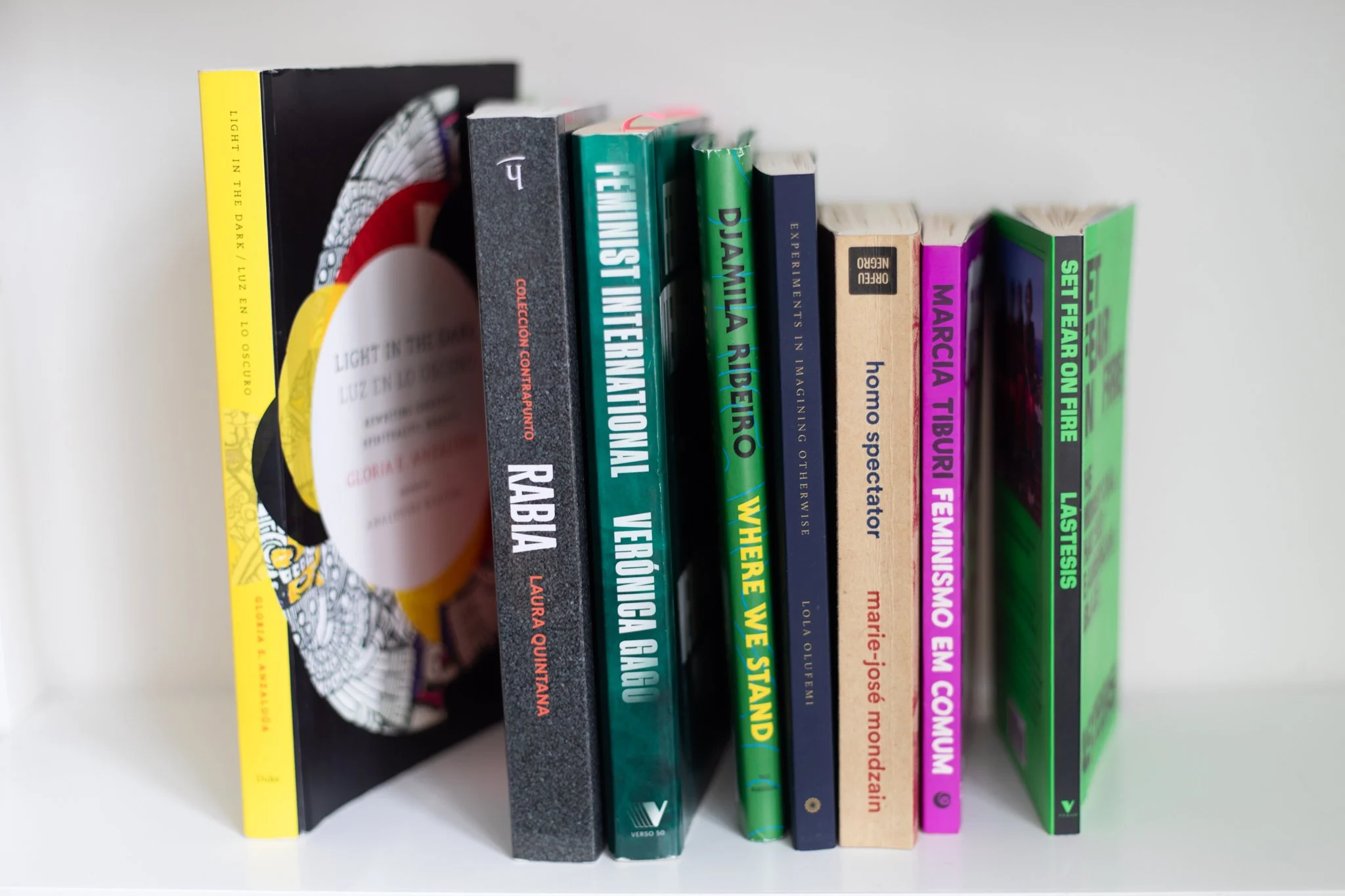a Reading list for Feminist Visual Potencia
10 selected reads to get started
Readings include books in English, Portuguese and Castellano
Vikki Marie Page. 04/09/2025.
Searching for and building the concept of Feminist Visual Potencia, entailed reading across feminist scholarship from Latin America where potencia feminista has been named, lived, and theorised with, while also including voices from beyond the region. It was out of this terrain that the Searching for Feminist Visual Potencia doctoral project emerged.
This list is composed of 10 of my favourite readings that influenced the idea of feminist visual potencia. These texts prompt us to think about how feminist potencia is expanding the force, reach, and imagination of feminisms.
This is not a closed list, but a fragment of readings and thoughts which spark feminist visions of potencia —a crossing of English, Castellano, and Portuguese.
1. Veronica Gago, Feminist International
Argentine feminist Verónica Gago directly develops the notion la potencia feminista (feminist potencia). She traces how feminist movements in Latin America are transforming politics by centering bodies, territories, and everyday life as spaces of struggle. She shows how collective force is generated through strikes, assemblies, and street mobilizations that expand what feminisms can do and who they speak for.
Gago, Veronica. 2020. Feminist International: How to Change Everything. Translated by Liz Mason-Deese. Verso Books: London.
2. Marcia Tiburi, Feminisms em Comum: Para Todas, Todes e Todos
Brazilian feminist, Marcia Tiburi explores the potencia of feminisms, seeing feminisms as plural, diverse and inclusive and expansive force which prompts us to reimagining social bonds. This short book invites us to into feminist thought and calls us into collective consciousness and shared struggle.
Tiburi, Marcia. 2018. Feminismo em Comum: Para Todas, Todes e Todos. Rosa dos Tempos: Rio de Janeiro.
3. Cecilia Palmeiro, The Latin American Green Tide: Desire and Feminist Transversality
Argentine feminist Cecilia Palmeito reflects on the mass mobilizations for abortion rights in Argentina and beyond, framing the marea verde (the green tide) as a movement driven by desire, creativity, and collective imagination. She shows how transversal connections across generations, geographies, and struggles, generate a force that is reshaping what feminist actions can be.
Palmeiro, Cecilia. 2018. “The Latin American Green Tide: Desire and Feminist Transversality.” Journal of Latin American Cultural Studies 27 (4): 561–564.
4. LASTESIS, Set Fear on Fire
Creative arts-activism Chilean feminist collective LASTESIS explore their methods, performances, and political interventions, tracing how their art-activism has ignited feminist protest performances across Latin America. LASTESIS share how embodied, visual, and performative practices turn feminist theory into collective action in the streets.
LASTESIS. 2023. Set Fear on Fire: The Feminist Call That Set the Americas Ablaze. Verso: London.
5. Gloria Anzaldúa, Light in the Dark/Luz en lo Oscuro: Rewriting Identity, Spirituality, Reality
Chicana feminist Gloria Anzaldúa weaves together theory, spirituality, and lived experience to propose new ways of understanding identity and social transformation from the borderlands. She explores and manifests through her work was in which imagination, spirituality, and embodied knowledge can expand feminist horizons and sustain collective struggle.
Anzaldúa, Gloria. 2015. Light in the Dark/Luz en lo Oscuro: Rewriting Identity, Spirituality, Reality. Edited by AnaLouise Keating. Durham: Duke University Press.
6. Djamila Ribeiro, Where We Stand
Brazilian feminist Djamila Ribeiro brings to the forefront urgency of Black feminist thought from Brazil into global conversation, grounding theory in lived experience and the politics of positionality. Djamila Ribeiro discusses how by questioning and reflecting on where we stand – on our social, racial, and historical positions – we can sharpen collective struggles and open space for transformative solidarities.
Ribeiro, Djamila. 2024. Where We Stand. New Haven, CT: Yale University Press.
7. Laura Quintana, Rabia: Afectos, Violencia, Inmunidad
Colombian feminist Laura Quintana explores the potencia of rage as a political affect that arises from wounds, exclusions, and the demand for recognition, while also interrogating its ambivalent ties to violence and immunity. Laura Quintana considers rage from a feminist perspective, seeing how it can be used as a generative force—fueling visibility, collective resistance, and new forms of political life.
Quintana, Laura. 2021. Rabia: Afectos, Violencia, Inmunidad. Barcelona: Herder.
8. Rita Segato, Contra-Pedagogías de la Crueldad
Argetnine feminist, Rita Segato explores the pedagogies of cruelty and how the power of patriarchy operates through logics and spectacles of cruelty across the world. Going in-depth into structures of violence, Rita Segato identifies mechanisms that feminisms must confront and transform, highlighting the collective power needed to dismantle systemic cruelty and imagine alternative social relations.
Segato, Rita. 2018. Contra-Pedagogías de la Crueldad. Buenos Aires: Prometeo Libros.
9. Marie-Jose Mondzain, Homo Spectator: Ver, Fazer Ver
French philosopher, Marie-Jose Mondzain whilst not speaking of feminism, her work brings forward the potencia of images and image making processes. She examines the political and ethical power of images, exploring how seeing and making seen are central to collective life. The visual is for Marie-Jose Mondzain, a site of intervention and transformation, where fear and courage appear and image making practices open up possibilities for create new ways of perceiving, relating and acting.
Mondzain, Marie-Jose. 2015. Homo Spectator: Ver, Fazer Ver. Prefácio e tradução Luis Lima. Ofreu Negro.
10. Lola Olufemi, Experiments in Imagining Otherwise
British feminist Lola Olufemi explores how feminist imagination can create alternative ways of living, relating, and organising beyond existing social constraints. She puts into practice throughout the book, experiments in imagining otherwise to create alternative, aesthetic and affective ways of thinking and doing which expand possibilities for feminist potencia.
Olufemi, Lola. 2021. Experiments in Imagining Otherwise. United Kingdom: Hajar Press.
If there are works that spark feminist visual potencia for you, that you want to see added to the list, email them to: embodiedimaginaries@gmail.com. Let’s build feminist visual potencia together.

